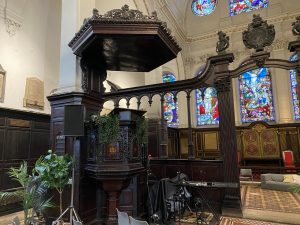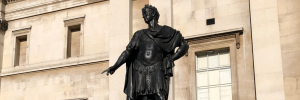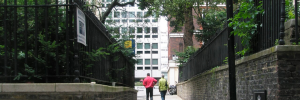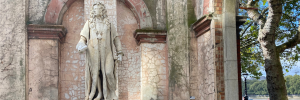The cluttered appearance was once typical of churches in London before twentieth-century ‘improvements’ tidied up their appearance.
Walk along Cornhill and you get a taste of what the City used to look like, with two churches, St Peter’s and St Michael’s, concealed from the street by other buildings. The front of St Peter’s is obscured by nineteenth-century shops, now made into a single food outlet, painted a rather unpleasant dark grey.
On-street level to the right of the shop(s) is the porch to the church marked out with a pair of round and another pair of square columns with Ionic capitals. Most of the architectural clutter around the City’s churches was removed in the twentieth century, leaving these two churches as a bit of a rarity. Another place to get a feel for this is St Stephen’s Walbrook where much of the masonry of the church frequently described as Wren’s ‘masterpiece’ is of a distinctly rough appearance, belying the previous presence of buildings up against it.

From across Cornhill the upper part of the north side of the church can be seen the tops of two windows and a third circular one above the porch. This view makes clear that the church runs off at an angle to the shop and street. The surrounding buildings give the porch and the church an alluring appeal, added to by the fact that the doors are normally shut. Thanks to the Friends of the City Churches (see www.london-city-churches.org.uk) St Peter’s is currently open on Tuesday afternoons between 13:00 and 16:00. Their website is very useful for giving the opening hours of all the churches they staff. The south side of the church can be seen from St Peter’s Alley, and the east is admired from Gracechurch Street.
This is a grand affair with five arched windows and is rare as a Wren-designed eastern facade. The interior has its original chancel screen plus a huge wooden pulpit. The inside was restored by JD Wyatt in 1872, one result of which is some intricate tiling on the floor. Some modern stained glass was added by Hugh Eaton in 1951 to 1960 in the aisles to commemorate Britain’s war dead. The artist’s evident interest in the male body sits incongruously with the ostensibly sombre theme of remembrance.
John Stow says: ‘There remaineth in the church a table whereon it is written, I know not by what authority, but of a late hand, that King Lucius [supposedly second-century AD] founded the same church to be an archbishop’s see metropolitan, and chief church of his kingdom, unto the coming of Augustin the monk’. There is no evidence of churches in London before the foundation of St Paul’s, so the story of the ancient foundation seems unlikely.
The first ‘solid’ mention of St Peter’s is from the 1120s. A Saxon foundation is however quite likely. The site is over that of the Roman basilica and is the highest part of the City which may have given it particular appeal for its putative Saxon founders. The medieval church was destroyed in the Great Fire. However, the tower rests on a vault of the fourteenth or fifteenth century.




